Every day, a vast amount of data is generated by people and companies.
This data generation has been growing exponentially in the last few years.
Many companies are integrating techniques that enable them to leverage the potential of this data by extracting valuable insights from it.
We can apply these techniques in many fields. For example, when talking about learning analytics, we refer to data analysis in education.
This post explains what learning analytics is and its most critical applications.
What is learning analytics?
Learning analytics (LA) is a relatively new field of research that has been emerging in the education sector.
It uses a set of tools to analyze the students’ data. Thanks to this, adapting each student’s course experience is possible, providing more efficient and dynamic learning methods.
Learning analytics aims to predict and advise on learning, further supporting faculty in identifying student learning needs and improving pedagogical strategies.
The following graph shows how the learning analytics process works:
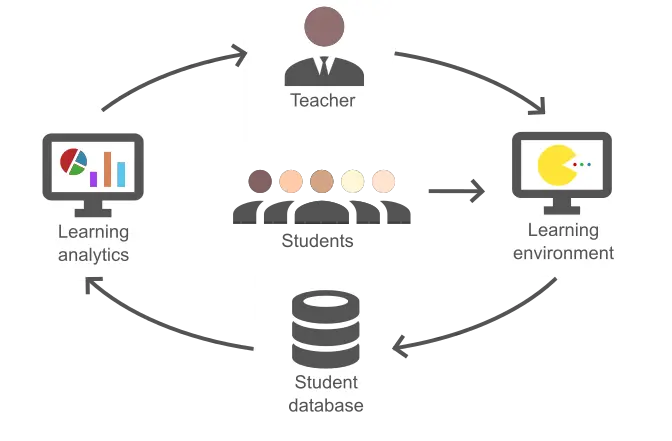
First, the teacher creates a learning environment, for example, a game or a quiz. Then, the students perform this task, and all this data about each student (score, engagement, etc.) is stored in a database. Afterward, this data is analyzed to obtain information, identify influencing variables, predict scores, and other relevant insights.
This analysis enables teachers to modify the learning environment to be more efficient and adapt to the students’ needs. Then, the same process is repeated over and over.
There are many applications of learning analytics, all aimed at better adapting teaching methods to students. In the following sections, we explain the most important ones.
Student monitorization
Data visualization is the main application of learning analytics. It aims to help instructors visualize and analyze the ongoing activities of the students.
Once the data is stored, it is possible to create dashboards that can be easily visualized.
The following chart shows an example of a dashboard:
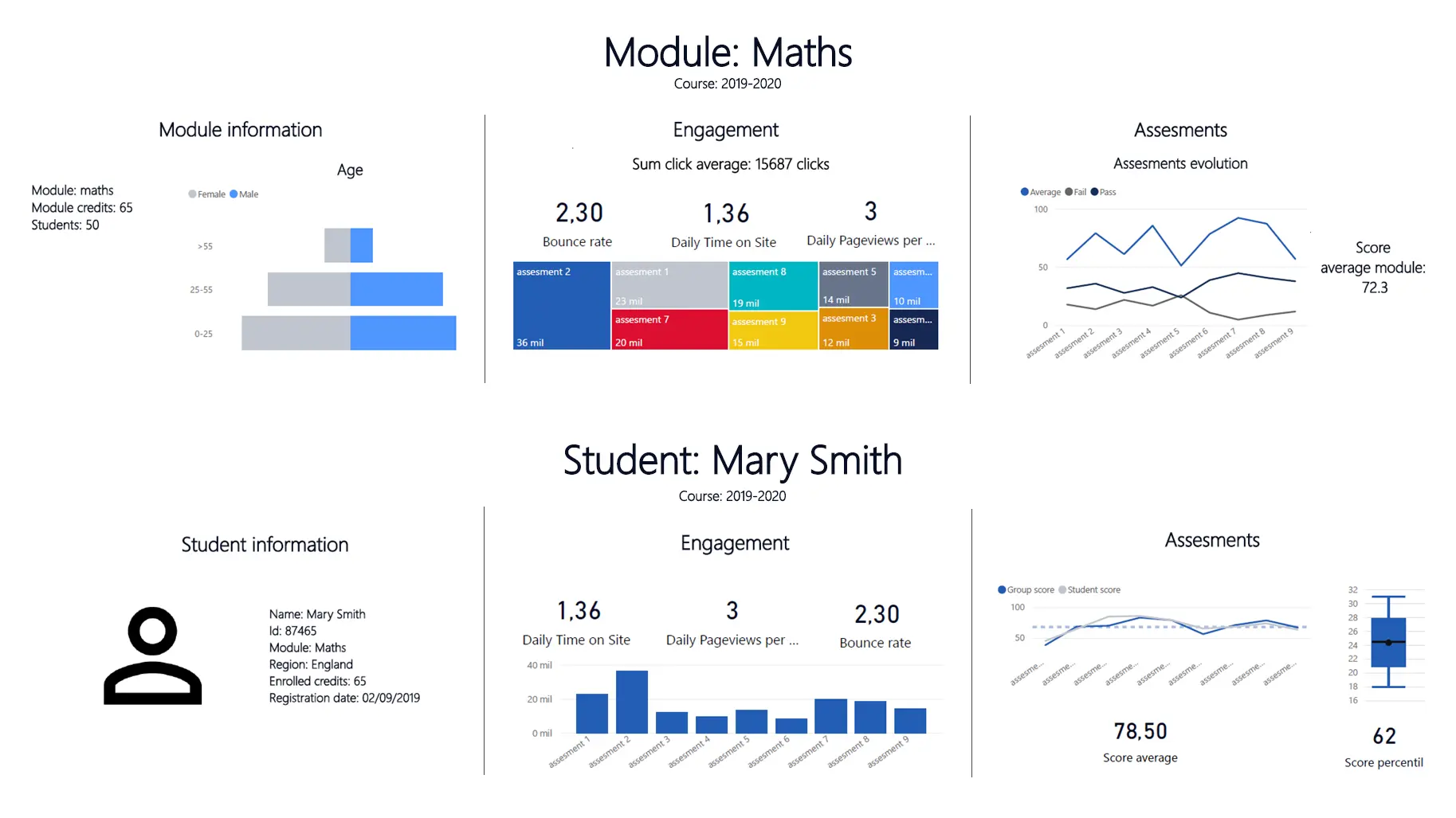
In this dashboard, we can visualize information about a course (Maths) and a student (Mary Smith).
The course visualization contains information about the Maths course. It includes credits and student numbers, score distribution according to gender, bounce rate, daily time on the site, distribution of the passes and fails in the different assessments, etc.
In the second part, we can visualize the data about a particular student, Mary Smith: her registration data, engagement, and score charts.
Many tools can be used for student monitoring, such as Power BI or Tableau. These tools are used to find insights into data and help create charts or graphs to provide data visuals.
Data visualization makes it easy to understand how your students engage with your content, so you can identify what is working and what is not, and then improve your methods accordingly.
Analysis of the factors influencing learning
Recognizing the most influential factors is another key to improving the learning methods.
If the teacher or the learning organization recognizes the most important aspects, they can pay more attention.
To find these factors, we calculate the input-target correlations, which calculate the correlations of all the variables with the target variable, for instance, the score.
The following chart shows which factors most influence the variable final_score.
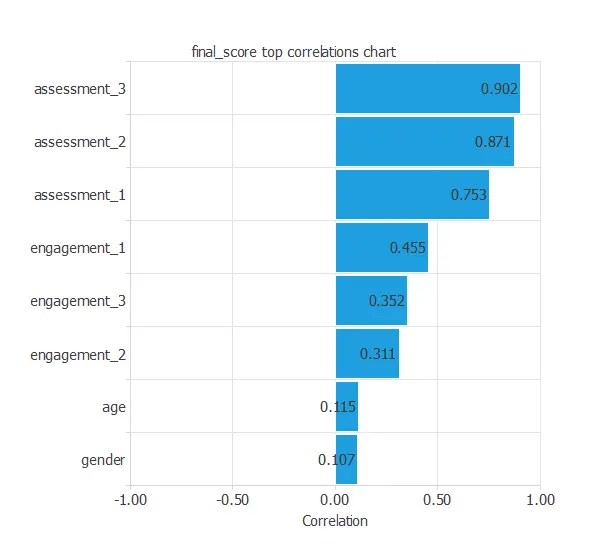
In this example, the most influential factors are the three assessments (assessment_3, assessment_2, and assessment_1) with a positive correlation; the better the assessment, the better the final grade.
The engagements (engagement_1, engagement_3, and engagement_2) also positively influence the final score, but to a lesser extent than the assessments.
Finally, the variables sex and gender have almost no influence on the final grade.
Student outlier detection
Outlier detection is also essential, especially to detect these students with difficulties or irregular learning processes so that the teacher can adjust the learning methods to their needs.
In the following plot, we can observe the student score as a function of student engagement. The minimum score is 0, and the maximum is 10. The engagement is measured by the number of times a student interacts with the material that day.
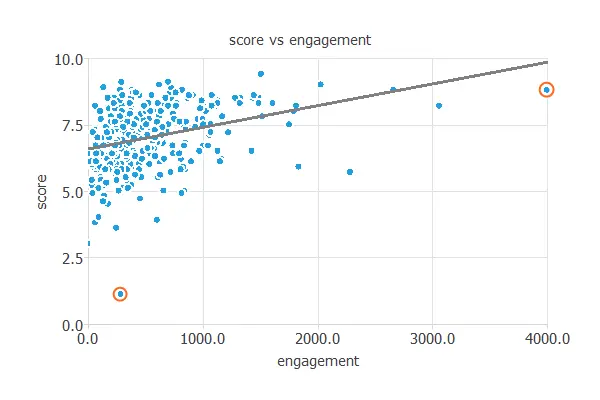
As we can see, two outliers were selected with the orange circles.
Regarding the student on the top-right side, although he has a good score (around 9), he needs to study eight times more than most students who get that mark. This might indicate different things, such as concentration problems or addiction to studying, and the teacher should look at this student.
There is another one on the bottom-left side. This student studies the same amount of time as many of his classmates. However, he fails the exam and receives a poor score (around 1). Looking at the other students with the same engagement (around 300), we observe that most pass the exam. This could indicate that this student has learning difficulties, and the teacher should also study this case.
Overall, any case far from the point of massing should be reviewed, as this person has a different learning process from the rest of the classmates and could indicate different learning problems.
Dropout and score prediction
Learning analytics is also used to predict scores and dropout probabilities.
It is possible to make predictions about a course, including how many students will pass, how many will fail, the churn rate, and the group average. It is also possible to make predictions about a specific student, including their predicted score and the probability of dropout.
The following chart shows an example of the predictions for the Maths course:
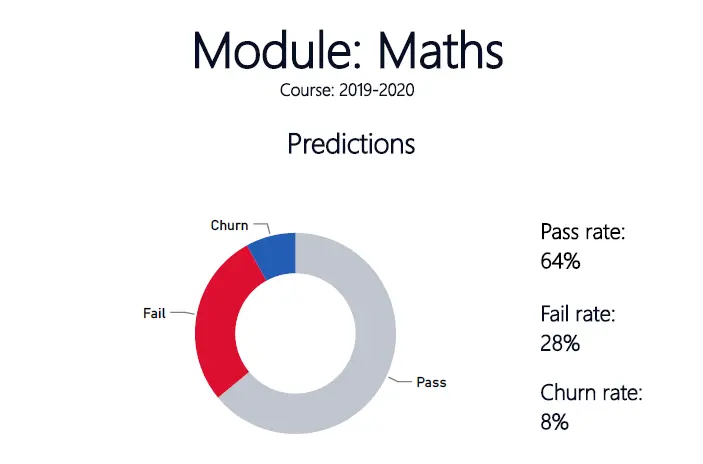
The Maths course is predicted to have a 64% pass rate, 28% fail rate, and 8% churn rate.
The following chart shows the predictions for the student Mary Smith:
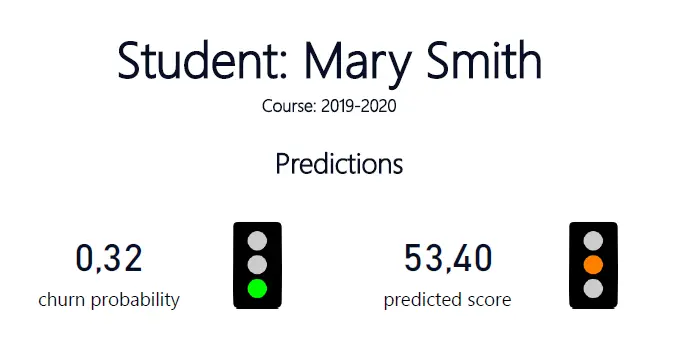
This student has a 32% churn probability; her predicted score is 53.40.
A standard algorithm for this is neural networks.
Neural networks
Neural networks can be defined as a biologically inspired computational model that consists of a network architecture composed of layers of artificial neurons.
This structure contains a set of parameters, which can be adjusted to perform specific tasks. Some examples include assessing dropout risk and predicting students’ final scores.
The following graph illustrates an example of a neural network used to predict the final student scores:
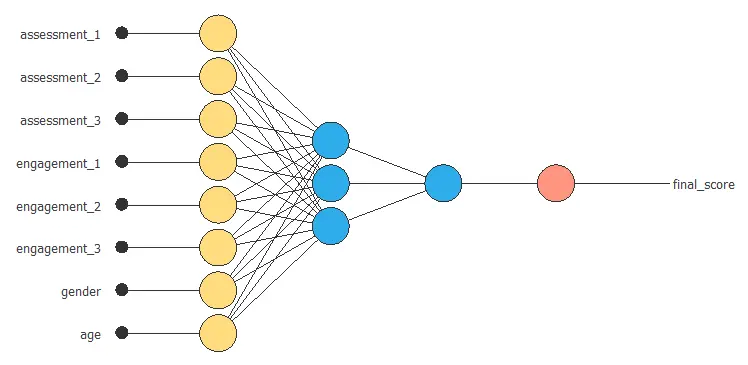
The yellow input layer consists of 8 neurons, one for each variable.
The example has two hidden layers (blue), the first one with three neurons and the second with only one neuron.
Finally, we can see the output layer in orange. Only one neuron corresponds to the output variable, the final score.
When we introduce the data for all eight variables, the hidden layers of the neural network work to return a value for the output, the predicted final score.
Course recommendation
Recommendations to students is another of the learning analytics applications.
Different recommendation algorithms are based on different features, such as content-based, collaborative, or conversational recommendation approaches. The following chart represents the content-based and collaborative filtering:
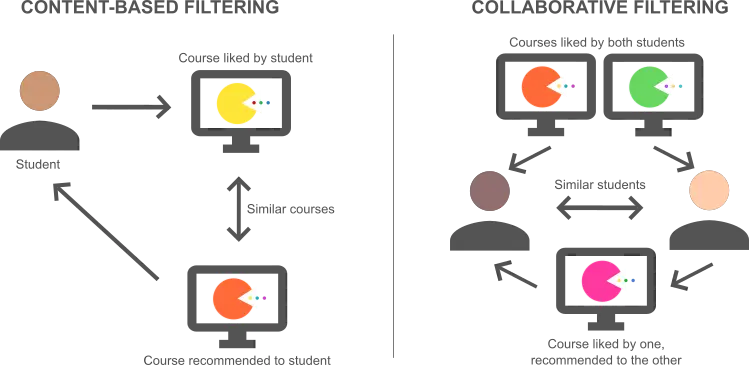
Content-based and conversational recommendation techniques enable students to interact with the course selection, whereas collaborative filtering utilizes the records of similar students to recommend courses.
These algorithms are used to match individual needs and interests. Finding the course that best suits these personal needs and interests helps reduce the dropout probability and improve engagement.
All this information can also be helpful for the academic planning of courses and the further development of learning programs.
FLIP2G project
“Enhancing education and training through data-driven adaptable games in flipped classrooms (FLIP2G)” is a project framed in the Erasmus+ Programme of the European Union to support education, training, youth, and sport in Europe.
This project is carried out by 7 European higher education institutions, schools, and private companies:
- Aalborg University (Denmark).
- Nurogames (Germany).
- University of Macedonia (Greece).
- Artelnics (Spain).
- Northumbria University (United Kingdom).
- Mandoulides Schools (Greece).
- Revheim School (Norway).
The Flip2G project aims to establish a Knowledge Alliance between higher education institutions, schools, and private companies to boost skills development and introduce novel, data-driven approaches to education and training.
The results will help establish a new pedagogical method that combines problem-based learning and flipped classrooms with game-based learning and produce informative insights into the learning process.
These techniques enable the creation of engaging models that foster motivation, generate custom learning pathways, and facilitate self-directed learning in education.
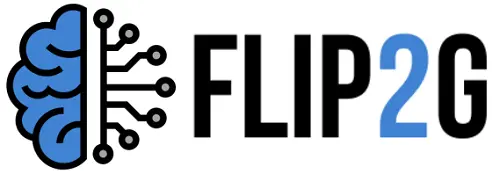

Conclusions
This post shows that learning analytics can improve students’ learning experience.
Learning analytics can support teachers and educational organizations in providing personalized student support and creating new pedagogical models. It collects and processes educational data to visualize past trends, identify the most influential factors, detect students with difficulties or irregular learning processes, predict future outcomes, and make course recommendations.
Organizations and projects such as Flip2G are already taking advantage of these techniques, and it is expected that many other educational organizations will also include them in the following years.

